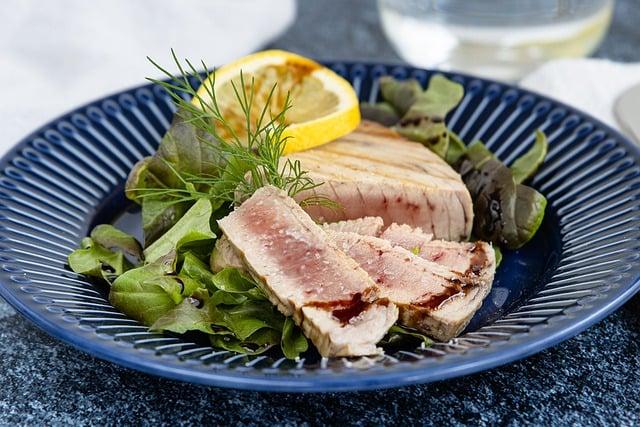Once upon a time in a cozy kitchen, a curious cat named Whiskers watched his owner prepare dinner. The tantalizing scent of tuna wafted through the air, and his eyes widened with excitement. Whiskers leaped onto the counter, purring with anticipation. His owner chuckled, recalling how tuna could be a delightful treat but also a potential health risk if given too often. With a gentle smile, she offered him a small taste, reminding herself that moderation was key. Whiskers savored the moment, knowing he was loved and cared for.
Table of Contents
- Understanding the Nutritional Benefits of Tuna for Cats
- Potential Risks and Considerations When Feeding Tuna to Cats
- How to Safely Incorporate Tuna into Your Cats Diet
- Alternatives to Tuna: Exploring Other Healthy Seafood Options for Cats
- Q&A
Understanding the Nutritional Benefits of Tuna for Cats
Tuna is often considered a delightful treat for our feline friends, but its nutritional profile offers more than just a tasty experience. Rich in **high-quality protein**, tuna provides essential amino acids that are crucial for maintaining muscle mass and overall health in cats. This protein source supports their energy levels and contributes to the development of strong tissues, making it a valuable addition to their diet when offered in moderation.
In addition to protein, tuna is packed with **omega-3 fatty acids**, which are known for their anti-inflammatory properties. These healthy fats can promote a shiny coat and healthy skin, reducing the likelihood of skin irritations and allergies. Omega-3s also play a role in supporting heart health and cognitive function, making tuna a beneficial option for cats of all ages.
Another noteworthy aspect of tuna is its **vitamin and mineral content**. Tuna is a good source of essential nutrients such as vitamin B12, which is vital for nerve function and the production of red blood cells. Additionally, it contains selenium, an antioxidant that helps protect cells from damage and supports the immune system. These nutrients contribute to the overall well-being of cats, enhancing their vitality and longevity.
However, it’s important to be mindful of the **potential risks** associated with feeding tuna. While it can be a nutritious treat, excessive consumption may lead to mercury exposure and nutritional imbalances. Therefore, it’s best to offer tuna as an occasional indulgence rather than a staple in their diet. By doing so, you can ensure that your cat enjoys the benefits of tuna while maintaining a balanced and healthy diet.
Potential Risks and Considerations When Feeding Tuna to Cats
While many cats may relish the taste of tuna, there are several potential risks associated with incorporating this fish into their diet. One of the primary concerns is the high levels of **mercury** found in many types of tuna. Cats that consume tuna regularly may be at risk of mercury poisoning, which can lead to serious health issues, including neurological damage. It’s essential to monitor the frequency and quantity of tuna offered to your feline friend to mitigate this risk.
Another consideration is the **nutritional imbalance** that can arise from feeding tuna as a primary food source. Tuna lacks certain essential nutrients that cats require for optimal health, such as taurine, which is crucial for heart and eye health. Relying too heavily on tuna can lead to deficiencies and health problems over time. Therefore, it’s vital to ensure that tuna is only an occasional treat rather than a staple in their diet.
Additionally, some cats may develop a **preference** for tuna, leading to a reluctance to eat their regular cat food. This can create a challenging situation for pet owners, as it may result in a picky eater who refuses to consume a balanced diet. To prevent this, it’s advisable to introduce tuna gradually and in moderation, ensuring that it does not replace their primary source of nutrition.
Lastly, there is the risk of **additives** and preservatives found in canned tuna products. Many commercially available tuna options may contain added salt or other ingredients that are not suitable for cats. Always check the labels and opt for tuna packed in water without any added seasonings or preservatives. This careful selection can help minimize potential health risks while still allowing your cat to enjoy the occasional fishy treat.
How to Safely Incorporate Tuna into Your Cats Diet
When considering adding tuna to your cat’s diet, it’s essential to do so in moderation. While tuna can be a delightful treat for your feline friend, it should not replace their regular meals. Cats require a balanced diet that meets their nutritional needs, and too much tuna can lead to health issues. Aim to offer tuna as an occasional snack rather than a staple food.
Choose the right type of tuna for your cat. Opt for canned tuna in water rather than oil, as the latter can be high in calories and fat. Additionally, avoid tuna that is seasoned or flavored, as these additives can be harmful to your cat. Always check the label to ensure that the tuna is free from any harmful ingredients, and consider purchasing tuna specifically formulated for pets.
Introduce tuna gradually into your cat’s diet. Start with small amounts to see how your cat reacts. Some cats may have sensitivities or allergies to fish, so it’s crucial to monitor for any adverse reactions, such as gastrointestinal upset or changes in behavior. If your cat enjoys the tuna and shows no negative effects, you can continue to offer it as an occasional treat.
Lastly, be mindful of the potential risks associated with feeding tuna. Tuna contains high levels of mercury, which can accumulate in your cat’s system over time. To minimize this risk, limit the frequency of tuna treats and consider alternating with other protein sources, such as chicken or turkey. By being cautious and informed, you can safely incorporate tuna into your cat’s diet while ensuring their overall health and well-being.
Alternatives to Tuna: Exploring Other Healthy Seafood Options for Cats
While tuna may be a popular choice among cat owners, it’s essential to consider other seafood options that can provide similar benefits without the potential drawbacks. Many cats enjoy the taste of fish, and there are several alternatives that can be both nutritious and safe for your feline friend. Exploring these options can help diversify your cat’s diet and ensure they receive a well-rounded array of nutrients.
One excellent alternative is **salmon**, which is rich in omega-3 fatty acids that promote a healthy coat and skin. This fish is also packed with protein, making it a great choice for maintaining muscle mass in active cats. When serving salmon, ensure it is cooked thoroughly and free from any seasoning or additives that could be harmful to your pet.
Another seafood option is **sardines**, which are not only tasty but also loaded with essential vitamins and minerals. Sardines are smaller fish that are typically lower in mercury compared to larger species, making them a safer choice for regular feeding. They can be served canned in water or oil, but always check for added salt or preservatives that could be detrimental to your cat’s health.
Lastly, consider **mackerel**, a fish that is both flavorful and nutritious. Mackerel is high in protein and contains beneficial fats that can support your cat’s overall health. Similar to sardines, mackerel is generally lower in mercury, making it a safer seafood option. When introducing any new fish to your cat’s diet, it’s wise to do so gradually and monitor for any adverse reactions.
Q&A
-
Can cats eat tuna?
Yes, cats can eat tuna in moderation. It can be a tasty treat for them, but it should not be a staple in their diet.
-
Is tuna safe for cats?
While tuna is generally safe, it should be offered as an occasional treat. Too much tuna can lead to mercury poisoning and nutritional imbalances.
-
What type of tuna is best for cats?
Plain, cooked tuna without added salt or spices is the best option. Canned tuna in water is preferable to tuna in oil or brine.
-
How often can I give my cat tuna?
Limit tuna treats to once a week or less. Balance it with a complete and nutritious cat food to ensure their dietary needs are met.
while tuna can be a tempting treat for your feline friend, moderation is key. Always prioritize a balanced diet and consult your vet to ensure your cat’s health remains purr-fectly intact. Happy feeding!

大家好,我是彼得潘,專業的手法身體治療師。我喜歡探索和研究各種主題,並透過與人工智慧的合作分享專業、實用、有趣的文章。我們定期進行人工審核,以確保內容的準確性。如果您發現文章中有任何不準確的地方,請隨時與我們聯繫,我們會及時糾正。您可以透過 [email protected] 與我們聯繫。



